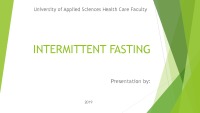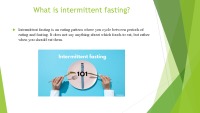Intermittent Fasting



Intermittent fasting. Content. What is intermittent fasting? Seven ways to do intermittent fasting. Fast for 12 hours a day. Fasting for 16 hours. Fasting for 2 days a week. Alternate day fasting. A weekly 24-hour fast. Meal skipping. The Warrior Diet. What are the benefits of intermittent fasting? Tips for maintaining intermittent fasting. Intermittent Fasting Side Effects. References.
Introduction Theoretical background Aim of our research Method of research Respondents Findings Conclusions Suggestions References.
Intermittent fasting is an eating pattern where you cycle between periods of eating and fasting. It does not say anything about which foods to eat, but rather when you should eat them.
The rules for this diet are simple. A person needs to decide on and adhere to a 12-hour fasting window every day. This type of intermittent fasting plan may be a good option for beginners. This is because the fasting window is relatively small, much of the fasting occurs during sleep, and the person can consume the same number of calories each day. The easiest way to do the 12-hour fast is to include the period of sleep in the fasting window. For example, a person could choose to fast between 7 p.m. and 7 a.m. They would need to finish their dinner before 7 p.m. and wait until 7 a.m. to eat breakfast but would be asleep for much of the time in between.
Fasting for 16 hours a day, leaving an eating window of 8 hours, is called the 16:8 method or the Leangains diet.
- Biology Presentations
- MS PowerPoint 649 KB
- 2020 m.
- English
- 16 pages (1074 words)
- College
- Gabija





